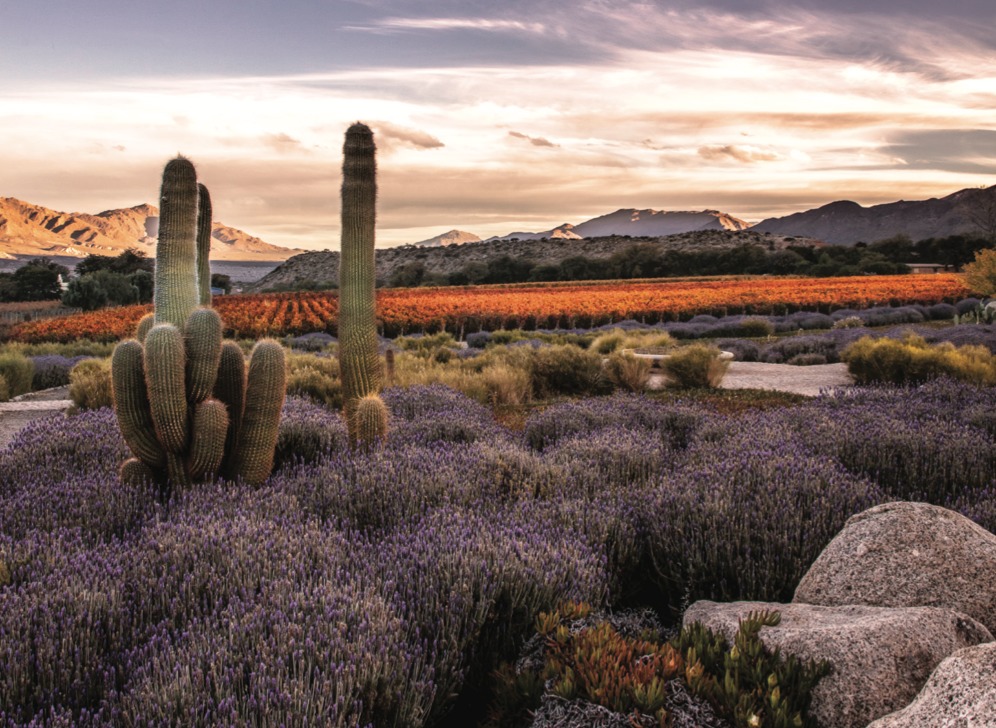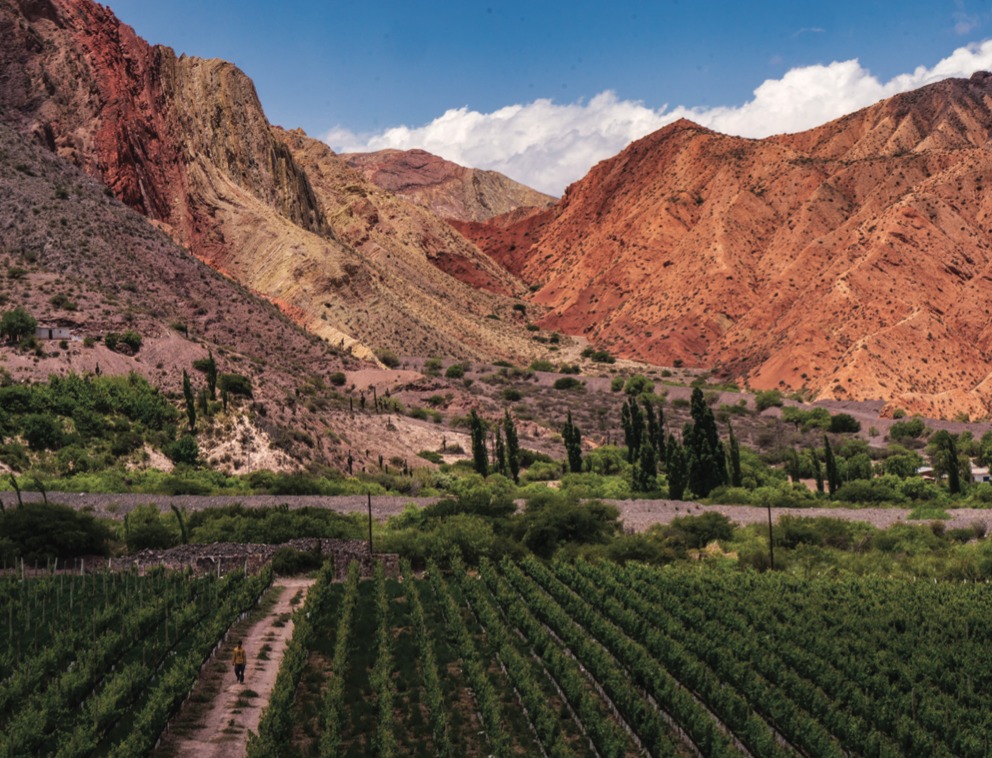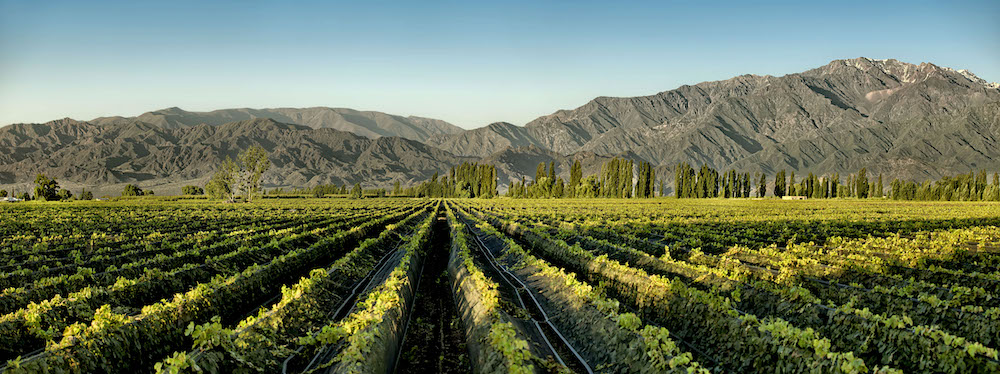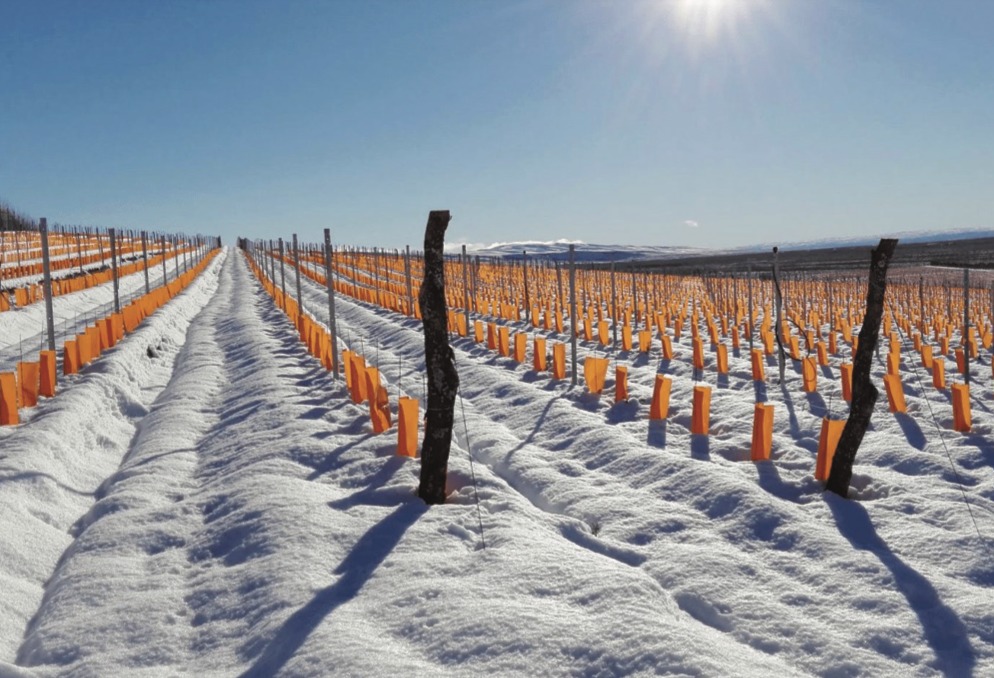Check out our ultimate Argentina wine guide and get to know everything about the terroir and the wine regions of Argentina.
Guide to wine regions of Argentina
Facts on Argentine wine
Northern Argentina wine regions: Salta, Catamarca & Jujuy
Cuyo wine regions: Mendoza, San Juan, San Rafael, La Rioja
Patagonia wine regions: Neuquen, Rio Negro & Chubut
Central & Atlantic Argentina wine regions
Map of Argentina’s wine regions
Most of Argentina’s wine regions are located along the western edge of the country, in the foothills of the Andes mountains that form a natural frontier with Chile. The foothills offer the ideal natural landscape for vineyards to be able to thrive in the desert, as they slope gently downwards and are irrigated by the rivers carrying snowmelt from the Andes down to the arid plains below.
From Río Negro in the south to Salta and Jujuy in the far north, most of Argentina’s wine regions share this dry, warm and sunny mountain climate and gradually sloping alluvial soils. However in recent years we’ve seen a steady growth and diversification of Argentina’s wine regions, expanding further south into Patagonia as well as eastwards into the Pampa and Buenos Aires.

Key Facts on Argentine wine
- Hectares planted: 197,965
- Producers: <900 wineries; 23,699 vineyards
- Production: 1.1 billion litres of wine (2020)
- Wine regions: Jujuy (42 ha); Calchaquí Valleys (4,468 ha); Catamarca Valleys (1,721 ha); La Rioja (6,539 ha); San Juan (31,960 ha); Mendoza (149,002 ha); San Luis (107 ha); Neuquén (1,764 ha); Río Negro (1,526 ha); Chubut (87 ha); La Pampa (279 ha); Córdoba (261 ha); Buenos Aires (148 ha); Entre Rios (49 ha); Misiones (12 ha); Santiago del Estero (1 ha)
- Most-planted varieties: Malbec, Cereza, Bonarda, Cabernet Sauvignon, Criolla Grande, Syrah, Torrontés, Pedro Giménez, Chardonnay, Tempranillo
The wine regions of Argentina
Northern Argentina
Jujuy
At the northernmost tip of Argentina, Jujuy is, in a word, extreme. Bordering southern Bolivia and the edge of Chile’s Atacama region, Jujuy has both jungle and desert salt flats but it is largely dominated by the high plateau of the altiplano which scales up to altitudes of over 5,000 metres.
The wine regions and vineyards of Jujuy are mainly in the narrow 80 km-long mountain valley and canyon of Quebrada de Humahuaca and the warmer valleys in the south known as the Valles Templados. Although there aren’t many vineyards in Jujuy (the region has just 42 hectares to date), Jujuy claims some of the highest-altitude vineyards in the world.

Calchaquí Valleys
The Calchaquí Valleys is one of Argentina’s most extraordinary wine regions and it has, remarkably, been producing wine for hundreds of years, despite the challenges of its high altitude and remote nature.
Old vines can be found throughout this string of mountain valleys which runs north to south, spanning over 270 km and three of Argentina’s provinces: Salta, Tucumán and Catamarca. The Calchaquí Valleys may only represent 2% of the country’s vineyards, but it claims a disproportionate share of Argentina’s wine awards — and with good reason, I say. High-altitude viticulture can be hard work, but it certainly reaps the benefits of distinctive personality and I never fail to be impressed by the incredible value and quality of Calchaquí wines.
Read more in our Guide to the Calchaquí Valleys wine region
Valleys of Catamarca
With over three-quarters of the province covered by mountains, Catamarca’s wine regions are unsurprisingly defined by their mountains and moderated by their altitude. Although Catamarca’s vineyard area is impressive in size, the wines are sadly less so. The province is a major producer of juice – so you won’t find as much wine coming out of Catamarca as you might expect – and also jug wine. Some of the better known wine regions of Catamarca are within the Calchaqui Valleys.
Cuyo wine regions
La Rioja
It’s no coincidence that this Argentine wine region shares its name with Spain’s most famous wine region. When a Spaniard from La Rioja named Juan Ramírez de Velasco came to Argentina in 1591 and founded a city there, he named it after his home region and called it Todos los Santos de la Nueva Rioja.
Although the wine regions share their name, La Rioja Argentina has little in common (and there are just 50-odd hectares of Tempranillo are planted). La Rioja’s most-planted and noteworthy grape variety is a white grape variety: Torrontés. The region’s red wines can offer great value, warmth and generosity, best for everyday wines.

Want to know more detail about
the wines & wine regions in Argentina?
Get your copy of the ARGENTINA WINE GUIDE E-BOOK
& the full, award-winning hardback THE SOUTH AMERICA WINE GUIDE
San Juan
San Juan is second only to Mendoza in terms of wine production and one of the unsung heroes of Argentine wine, home to a fifth of Argentina’s vineyards and making – mainly red – wines that deliver good value. I’m particularly excited about the top-quality wines coming from the higher-altitude vineyards of Pedernal and La Ciénaga, which can rival the quality of many wines from the Uco Valley. Another exciting development in San Juan is the exploration of old Criolla vines planted at high altitude in Calingista, which reveal a totally different side to this otherwise quite prosaic wine region.
Mendoza

Mendoza is undoubtedly the nerve centre of South American wine. This is where over 70% of Argentina’s vineyards and wine production are concentrated and Mendoza has more land under vine than the whole of Australia.
The three major regions to get your head around in Mendoza are Maipú, Luján de Cuyo and the Uco Valley. However, there’s plenty more to discover in Mendoza, such as the old-vine renaissance happening in the far east, the new terroirs being explored in Las Heras and the vineyards and canyons of San Rafael.
Maipú and Luján de Cuyo sit side by side to the south of Mendoza city, separated by just a road. Luján de Cuyo extends westwards and Maipú extends towards the east. Luján de Cuyo is a landmark wine region for Argentina and was the first Argentine region to achieve DOC status in 1989. The region has one of South America’s most-visited wine routes, with a highly diverse range of producers in terms of size, style and personality within a short distance of one another.
The Uco Valley has become one of the top wine regions in Latin America. Recognised not only for its fresher Malbec wines with brighter acidity and chalkier tannins and texture, but also for top-quality white wines: complex and mouth-watering Chardonnay, lean and refreshing Sauvignon Blanc and elegant sparkling wines. A gamut of lighter-coloured red wines, from peppery and floral Cabernet Franc to crunchy and aromatic Pinot Noir, have also contributed towards defining the new wine styles both of the Uco Valley and of Argentina as a whole.
Read more about the wine regions in Mendoza in our guides to Las Compuertas in Lujan de Cuyo, Gualtallary in the Uco Valley, Los Chacayes in the Uco Valley, Paraje Altamira in the Uco Valley, San Rafael and General Alvear in the Uco Valley
San Luis
There’s a new wine industry emerging in San Luis, a small Cuyo province just east of Mendoza. With half a dozen producers today, a few pockets of vineyards are beginning to produce their first vintages.
Patagonia
Río Negro & Neuquén
There is a lot to be excited about in Río Negro, and the region produces some of my favourite Argentine wines, which are distinctive because of their balance and elegance. What’s more, many of the remaining vineyards have very old vines. Particularly exciting here is the old-vine Malbec, which displays soft red and black fruit, exotic spice and earthy aromas with fine tannins, as well as old-vine Cabernet Sauvignon and Merlot.
Neuquén is better known for its rich red wines: bold Malbec, full-bodied Cabernet Sauvignon and Cabernet Franc, and a much broader, richer style of Pinot Noir than that from Río Negro. Neuquén is a new wine region that is still evolving its wine identity, but its vines are beginning to take deeper root as winemakers begin to understand their new stomping ground in this ancient, dinosaur-laden terroir.
Read more in our Guide to Rio Negro wine region
Chubut
Chubut is the new frontier for Argentine wine. The southernmost wine region in Argentina, it was once considered as far too cold to ever produce grapes. However, since the early 2000s there has been a steady increase in plantings and a promising new production from this cool climate. Otronia vineyard is, in fact, the southernmost vineyard and winery in the world!

Central, Eastern & Atlantic Argentina
The commercial development of these central, eastern and coastal regions is a new one — with most of the vines being planted since the 1990s. There were some historical vines in the regions of Santiago del Estero and Cordoba, however, in recent years we’ve seen more growth in the central and eastern regions. Cordoba in particular is quite promising with new vineyards being developed in the hillsides beyond the city.
Buenos Aires province has always had some table wines, however there is a new face for coastal Argentine wine emerging with plantings for fine wines near the coast. The pioneer and leader is Trapiche’s Costa y Pampa vineyard. Further south, there have also been some key coastal developments in Rio Negro, and the most notable producer there is Wapisa.
Map of Argentina’s wine regions
Want to learn more about the wines of Argentina?
Argentina wine vide guide - explore the wines of Argentina Celebrating Malbec Day with a terroir tour of Malbecs Barreal: Discovering a desert oasis in the mountains & treasure trove of Criolla vines Cafayate travel guide Wine in Chubut & the world's southernmost vineyard


